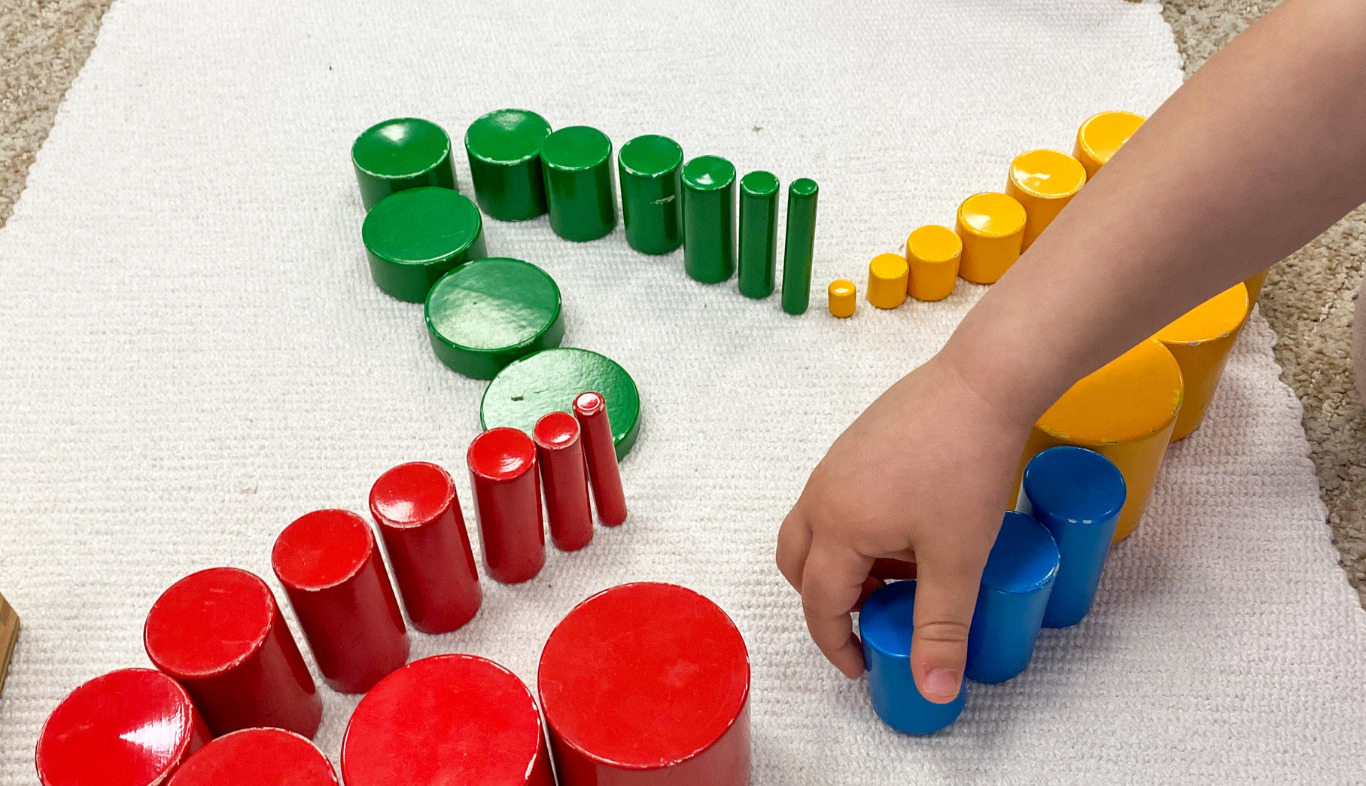Learning begins at birth when a child observes through their senses (e.g., sight, taste, smell, hearing, touch). This is the reason why newborns respond to sound and touch. Sensory learning is a natural way for children to learn about their environment and from real-life experiences to develop problem-solving skills.
“The senses, being explorers of the world, open the way to knowledge. Our apparatus for educating the senses offers the child a key to guide his explorations of the world…” (Montessori, 1967)
Dr. Montessori’s insight into educating the child’s senses is a remarkable aspect of her method. According to her research, the five senses of taste, touch, sight, smell, and sound stimulate a child’s understanding of the physical, social, material, and natural worlds. Thus, experimenting with sensorial activities helps children comprehend information about their world.
This article discusses how sensorial play teaches children about their five senses and why it is important to incorporate them into the Montessori classroom. Finally, the article explains how to incorporate sensorial play into your home or life.
What is Sensorial Learning?
“Tell me, and I forget. Teach, and I remember. Involve me, and I will learn.”
This statement is attributed to Benjamin Franklin, and the sentiment applies to the early age of development.
Sensorial learning is a teaching method that stimulates a child’s five senses: touch, hearing, sight, taste, and smell. It includes activities that help them learn about colors, numbers, shapes, textures, object sizes, etc. It serves as a stepping stone to organized intelligence, allowing children to adapt to their environment. Sensorial exercises help children learn how to organize their environment, classify objects, and use logic in order to make sense of the world around them. It also teaches perspective, discrimination, and order.
For example, a child might be asked to identify an object by touching it or asking what food they think is based on its smell and taste. Sensorial learners are often more engaged than visual learners because they have more sensory input about the material being studied.
Benefits of Sensorial Activities to the Child.
- It helps children develop a rich vocabulary, explore their environment, and experience different textures.
- It helps them understand their own emotions through self-awareness and mindfulness.
- It teaches children how to focus on one thing at a time without being distracted by other distractions in their surroundings.
- It enhances a child’s ability to remember what they have learned by allowing them to learn through experience.
- It helps them build necessary skills that include cognition and logic.
- It builds nerve connections in the brain’s pathway by accomplishing more intricate tasks stimulating their senses.
- It helps develop social skills, gives them a sense of belongingness, develops their compassion, practices empathy, and enhances their communication skills.
Why do Sensorial Activities Play an Important Role in Montessori?
Sensorial activities play a crucial role in the development of the whole child. Children learn to perceive, interact, and experience the world around them and get prepared for success in higher education, life, and well-being. A Montessori classroom is designed meticulously to emphasize all five senses to introduce and develop everything that can be perceived. It helps prepare the children’s mathematical minds and encourages early language skills.
In a Montessori curriculum, sensorial activities are incorporated into all areas of learning. When compared to conventional education, Montessori education stands out because of its holistic approach to learning. Educating the whole child helps the school focus on all aspects of a child’s development, i.e., intellectual, emotional, physical, and social.
“Our work is not to teach but to help the absorbent mind in its work of development. How marvelous it would be if by our help, if by an intelligent treatment of the child, if by understanding the needs of his physical life and by feeding his intellect, we could prolong the period of functioning of the absorbent mind!” ― Maria Montessori, in The Absorbent Mind.
In a Montessori school, sensory play is set up in a prepared environment with controlled levels of error, so that children can safely explore and learn differences and similarities in their environment using their senses. It provides a child with an enormously rich sensory experience that promotes structured growth and development more than any other form of learning. Thus, helping children make connections in the brain increases memory and cognitive ability.
List of Montessori Sensorial Activities
Dr. Maria Montessori divided a child’s sensory learning into eight categories:
- Visual work– As the name suggests, the purpose of visual work is to help children categorize and notice the similarities and differences in objects they see. It includes discrimination to dimension (size, length, width, and breadth of objects), color (color awareness), and form (shape awareness). Activities included are:
- Dimension:
- Pink Tower,
- Brown Stairs,
- Knobbed and Knobless Cylinders,
- Red Rods, etc.

- Color:
- Primary Colors Box,
- Secondary Colors Box 2,
- Secondary Color Wheel,
- Value (Black, White, Gray) Color Tablets,
- Mixing Black and White, color Gradation Color Box 3
- Form:
- Tactile work- It focuses on enhancing the sense of touch to heighten their perception and understanding of the world around them. The purpose of tactile work is to help children develop the ability to discriminate between coarse and fine when they touch. Activities included are:
- Mystery Bags or Stereognostic Bags
- Matching Mystery Bag
- Rough and Smooth Touch Boards
- Rough and Smooth Touch Tablets
- Fabric Box

- Baric work- It aims to help children learn about pressure and weight. It helps them to understand the objects around them and think critically. Activities included are Baric tablets.
- Thermic work- The thermic activity aims to help children distinguish between temperatures and develop their sense of temperature. It includes hot and cold, warm and cool, and the relationship with the temperature of the child’s own body. Activities included are:
- Thermic Bottles, and
- Thermic Tablets.
- Auditory work- As the name suggests, this work helps a child in improving their sense of hearing. It helps children to differentiate between distinct sounds and heightens their ability to notice variations in sound. Activities included are:
- Montessori bells, and
- Sound cylinders.
- Olfactory work- The purpose of olfactory work is to develop the children’s sense of smell. It helps them to differentiate between distinct smells. Activities included are: smelling bottles.
Montessori Smelling Bottles - Gustatory work- It aims to help children explore their sense of taste (Is it sour, bitter, or sweet?). In these exercises, a child will learn to differentiate between a variety of food and taste. Activities included are:
- Tasting food prepared by various practical life activities, such as grating, slicing, and
- Tasting bottles.
- Stereognostic work – It is also known as tactile gnosis, the sixth sense, or muscle memory. The purpose of stereognosis work is to develop the tactile or the sixth sense by using a sense of touch. It helps a child increase the ability to recognize or characterize an object without using sight, sound, smell, or taste. Activities included are:
- Mystery bags,
- Painted and sandpaper globes,
Throughout the Montessori curriculum, multiple sensorial activities focus on descriptive language, recognizing, observing, categorizing, and matching patterns, etc. It not only helps a child improve their senses but also helps them to become independent and confident.
Why is it Important to Incorporate Sensorial Activities in a Classroom?
With unavoidable situations like the pandemic, more and more children are growing up in the digital era. We need to be concerned that they don’t have the opportunity to explore all of their senses. Thus, we, as parents and educators, should be responsible for providing them with a solid foreground for education. Providing more abstract education that focuses on physical and mental engagement from an early age is important.
Montessori sensorial play is learning that every child will love. Dr. Maria Montessori’s introduction focuses on training children into healthy, happy, confident, and independent adults. It allows them to build critical skills needed for their development and beneficial relationships with the world around them.
Sensory activities introduce complex, abstract concepts to children tangibly and experientially. Thus, this approach sets the foundation for all further academic pursuits and provides an incredible educational experience. It is a learning that children will carry through their life. The sooner children are exposed to different sensory activities, the better they will observe, understand, and process the information.
How to Incorporate Sensory Play at Home?
Incorporating sensorial work into your home can be done by creating an environment well-prepared where children can explore, learn, and understand their world through the five senses.
A sensory table is a great way to engage children with their environment and help them explore the world through their senses. It can be purchased online or made at home using various materials, as it is easy to prepare. These tables are great for helping children explore their world through the five senses of sight, sound, touch, hearing, and sense of taste. It is amazing what children will discover that they can do with these sensory tables.
You can also use those, as mentioned earlier, Montessori sensorial activities and incorporate them along with the regular activities prepared at home. For example, if a child is learning food preparation, you can add gustatory activities. If a child is learning to recognize objects, put miniature objects into a bag, make it a mystery bag, and ask them to put their hand in the bag and pick one object and ask them to guess the object they are holding, and so on.
Each of the Montessori sensorial play activities is easy to set up at home and is also fun. These activities allow children to identify objects with their senses while learning new ideas.
Final Words
In the coming future, a child’s development is not only about their brain. A child needs to grow with knowledge that lasts long, sensorial play benefits children because of its rich, abstract nature. Children enjoy their activities and develop their senses, cognitive skills, and overall growth.
References
- Montessori, M. (1967). The Discovery of the Child. Fides Publishers.
- Montessori, M. (1967). The Absorbent Mind (C. A. Claremont, Trans.). Holt, Rinehart and Winston.










